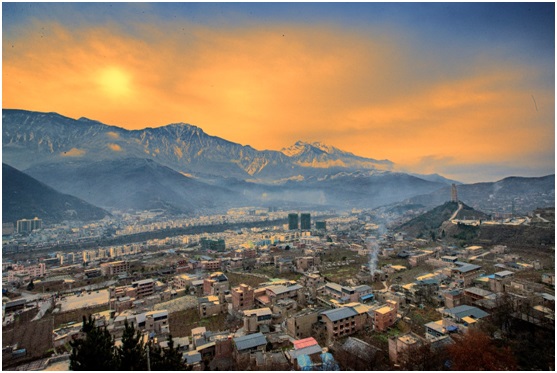By Lin Zhibo, Wang Mingfeng, People’s Daily
The last 16 impoverished counties in Tibetan-inhabited areas in southwest China’s Sichuan province have been removed from the country’s list of impoverished counties, the Sichuan Provincial People’s Government announced on Feb.18.
The 16 counties include Heishui county, Rangtang county and Aba county in Aba Tibetan and Qiang Autonomous Prefecture, and Yajiang county, Luhuo county, and Seda county in Garze Tibetan Autonomous Prefecture. So far, all the 32 counties in the Tibetan areas in Sichuan have shaken off poverty, including Muli county in Liangshan Yi Autonomous Prefecture.
People of Tibetan ethnic minority group live in two prefectures in Sichuan province, namely, the Aba Tibetan and Qiang Autonomous Prefecture, and the Garze Tibetan Autonomous Prefecture, and in Muli county, Liangshan Yi Autonomous Prefecture.
By the end of 2013, there were 2,063 poverty-stricken villages and 360,000 impoverished people in Tibetan-inhabited areas in Sichuan, and the incidence of poverty stood at 20.1 percent.
As of the end of 2019, all the 32 poor counties and 2,063 poor villages had shaken off poverty, and the poor population and poverty incidence of the Tibetan areas had been reduced to 2,400 and 0.1 percent, respectively.
In recent years, Sichuan province has intensified efforts to formulate favorable policies and provide strong support and guidance for industrial development and poverty alleviation in Tibetan-inhabited areas, concentrating superior forces for poverty alleviation in impoverished Tibetan-inhabited areas.
In 2013, Sichuan province focused its efforts on the implementation of six projects for improving people’s livelihood, with capital projects targeting poverty-stricken counties in Tibetan areas and favorable policies prioritizing support for such industries as education, health, transportation, and water conservancy.
In 2017, the province issued guidelines on four major tasks for poverty alleviation, including enhancing support for poverty alleviation, accelerating construction of industrial parks, and implementing the project for promoting the role of talents in revitalization of rural areas, further intensifying support and assistance for severely impoverished areas.
Sichuan has accumulatively allocated 10.76 billion yuan (about $1.53 billion) as special government funds for poverty alleviation and integrated around 28.69 billion yuan of government funds concerning agriculture and rural areas to help with the task of alleviating poverty in Tibetan-inhabited areas.
The province pays high attention to improving the lives of Tibetan people. The province has earnestly implemented a strict responsibility system to address school dropout rates and ensure attendance, and created five innovative systems to make sure that all school-age children from poor families receive compulsory education.
The five innovative systems include comparing information of household registration system and student status management system on a regular basis, implementing centralized management for identity cards of students enrolled in compulsory education, and compensating overage students for the school education they have missed.
Besides, the province has promoted expansion and quality improvement of free education by continuously implementing 15-year free education in regions inhabited by ethnic minorities and three-year free vocational education after nine-year free compulsory education in Tibetan-inhabited areas.
It has made efforts to speed up standardization of medical and health institutions throughout the province. So far, health centers in towns and clinics in villages of impoverished counties of Sichuan province have all met relevant standards.
In addition, the individual contributions of Sichuan’s poor population to the basic medical insurance schemes for urban and rural citizens are fully paid by government, while the proportion of medical expenses paid by poor households for medical treatment in their counties has been kept within 5 percent.
Sichuan has also worked with various forces around the country to form concerted efforts to help its Tibetan-inhabited areas overcome poverty.
Under the province’s efforts to give stronger support to targeted poor areas and encourage the eastern region to help in the alleviation of poverty in the western region, 34 counties in 8 cities from Guangdong and Zhejiang provinces have partnered with 32 impoverished counties in Sichuan’s Tibetan-inhabited areas.
The province also communicated with the 5 units of the central government helping lift targeted Tibetan-inhabited areas out of poverty, and helped expand and innovate poverty alleviation ideas for 9 counties in these areas.
Besides, Sichuan enhanced the efforts of the units in the province on poverty alleviation pair work in Tibetan-inhabited areas. It ensured that every impoverished county was assisted by 1 to 3 departments (units) directly under the provincial government, 1-3 institutions of higher education, more than 1 medical institution and 1 to 3 state-owned enterprises and financial institutions.
Twenty-three counties in the relatively developed 6 cities of the province paired with 32 impoverished counties in Tibetan-inhabited areas, and each one of the former would allocate around 0.3 to 0.5 percent of their fiscal revenue to help the latter each year.
It is reported that Sichuan province will enhance its monitoring to prevent the reoccurrence of poverty and improve its dynamic assistance mechanism. Besides, it will also strengthen supporting policies for employment to consolidate its achievements in poverty alleviation.
Picturesque scenery of Mao county in beautiful fog and clouds in Aba Tibetan and Qiang Autonomous Prefecture, southwest China’s Sichuan province, Dec.20, 2019. (Photo by Liu Guoxing/People’s Daily Online)










Leave a Comment